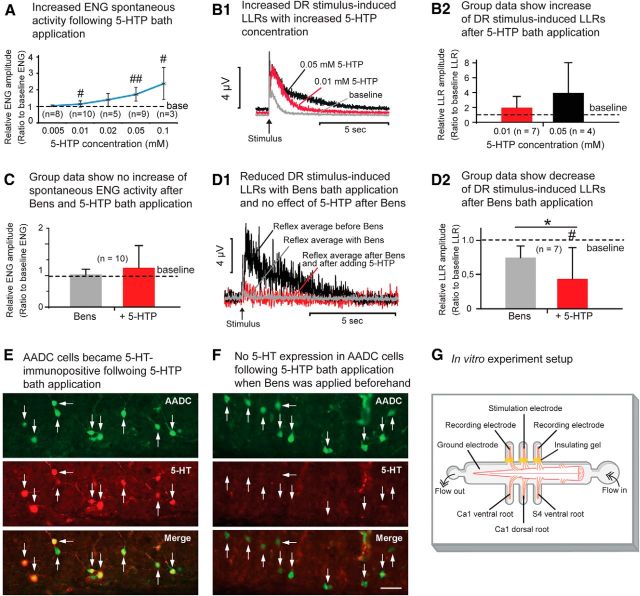Figure 7.
In vitro electrophysiological experiments show that 5-HTP increases spinal motoneuron excitability in chronically spinalized rats. A, Line graph illustrates the progressive increase in spontaneous ENG activity with increasing concentrations of 5-HTP in the bath solution. Comparison of the ENG amplitude was between baseline value and that after 5-HTP application in each group (#p < 0.05, ##p < 0.01, paired t test or Z test). B1, Rectified ENGs show how the dorsal root (DR) stimulus-induced LLRs increased with increasing concentrations of 5-HTP in a 71 d spinalized rat. B2, Group data show a dramatic increase of DR stimulus-induced LLRs after 5-HTP bath application compared with the baseline level. At 0.01 mm concentration the LLR increase was 94.6%, whereas at 0.05 mm the increase was 292.8%. However, due to the large variations between the cases, the differences were not statistically significant (p > 0.05, for comparisons with the baseline in each treatment group, paired t test). C, Group data (53–126 d spinalized rats) show no increase in LLRs following 5-HTP bath application (0.05 mm) when the AADC enzyme was blocked by benserazide hydrochloride (Bens; 0.3–0.5 mm). There was no significant difference in LLR duration after the application of Bens alone or following 5-HTP application compared with the baseline results for either treatment group; there was no significant difference between the two groups (p > 0.05 for all comparisons, Z test). D1, Rectified ENGs show that Bens bath application (0.3 mm) reduced the DR stimulus-induced LLRs and also blocked the effect of 5-HTP (0.05 mm) in increasing the amplitude of LLRs in a 122 d spinalized rat. D2, Group data show the reduction in the amplitude of DR stimulus-induced LLRs following bath application of Bens (0.3–0.5 mm). On average, the LLR amplitude was 24.2% lower than the baseline level after Bens application, but this reduction did not reach significance. The subsequent 5-HTP (0.05 mm) application did not increase the LLR (actually the amplitude was further decreased, probably due to an increasing effect of benserazide with time, and this decrease reached significance; p < 0.05, paired t test). E, AADC and 5-HT immunolabeling of an S4 spinal cord section from an 81 d spinalized rat following 0.05 mm 5-HTP application in aCSF without prior Bens application. Note that all of the AADC cells were double labeled with 5-HT. F, AADC and 5-HT immunolabeling of an S4 spinal cord section from a 58 d spinalized rat following 0.05 mm 5-HTP application in the aCSF with prior Bens (0.3 mm) treatment. Note that no AADC cells show 5-HT immunoreactivity. Scale bar, (in F) E, F, 50 μm. G, Schematic illustration of the in vitro recording setup with the sacrocaudal spinal cord ventral side up in the recording chamber.

